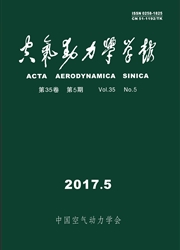

 中文摘要:
中文摘要:
基于计算流体动力学方法建立了龙卷风发生装置的数值计算模型,对具有单涡结构的龙卷风风场特性进行了研究。分析了切向风速沿径向和高度的分布规律,并将切向速度沿径向的分布与Rankin涡模型和参数化气旋模型理论公式进行对比,验证龙卷风风场数值模拟结果的合理性。进一步研究了入口风速和入口角度改变对龙卷风风场特性的影响,并给出了各个数值计算模型近地面核心半径、最大切向风速和涡流比,进而可以获得不同尺度和不同强度的龙卷风风场。该方法为龙卷风风场模拟提供了新的研究途径,并可应用于建筑物的抗龙卷风设计研究。
 英文摘要:
英文摘要:
Based on computational fluid dynamics (CFD), a numerical model of tornado generator was es- tablished and the characteristics of tornado wind field with a single vortex structure were studied. Radial and altitudinal distributions of the tangential velocity were presented, and the comparison of the radial distribu- tion of tangential velocity with the theoretical formulas of Rankine vortex model and parameterized cyclone model was conducted, so as to verify the rationality of the numerical simulation results of tornado wind field. Influences on characteristics of tornado wind field were further studied by changing the inlet angle and veloci- ty magnitude. The parameters of each numerical calculation model were given, which include core radius, maximum tangential velocity and swirl ratio near surface. Therefore, the tornado-like wind field with differ- ent intensities and scales was obtained. The present method provides a new approach to simulate tornadoes and can be used for study on tornado-resistant building designs.
 同期刊论文项目
同期刊论文项目
 同项目期刊论文
同项目期刊论文
 Investigation of a hybrid approach combining experimental tests and numerical simulations to study v
Investigation of a hybrid approach combining experimental tests and numerical simulations to study v A numerical and experimental hybrid approach for the investigation of aerodynamic forces on stay cab
A numerical and experimental hybrid approach for the investigation of aerodynamic forces on stay cab Numerical Investigation on the Aerodynamic characteristics of a Forward Flight Flapping Airfoil with
Numerical Investigation on the Aerodynamic characteristics of a Forward Flight Flapping Airfoil with Observational analysis of asymmetric distribution of convection associated with tropical cyclone “ch
Observational analysis of asymmetric distribution of convection associated with tropical cyclone “ch Characteristics of the offshore extreme wind load on parameters for wind turbines during strong typh
Characteristics of the offshore extreme wind load on parameters for wind turbines during strong typh Atmospheric boundary layer characteristics over the Pearl River Delta, China, during the summer of 2
Atmospheric boundary layer characteristics over the Pearl River Delta, China, during the summer of 2 Numerical simulations of cross-flow around four square cylinders in an in-line rectangular configura
Numerical simulations of cross-flow around four square cylinders in an in-line rectangular configura Bifurcation and chaos of a cable-beam coupled system under simultaneous internal and external resona
Bifurcation and chaos of a cable-beam coupled system under simultaneous internal and external resona Simulation of flow past cable with upper rivulet on its surface and investigation of the cable dynam
Simulation of flow past cable with upper rivulet on its surface and investigation of the cable dynam Wind Speed Profile and Gradient Height in Typhoons Observed by Vehicular Doppler Radar in South Chin
Wind Speed Profile and Gradient Height in Typhoons Observed by Vehicular Doppler Radar in South Chin A METHOD OF INITIAL VORTEX RELOCATION AND NUMERICAL SIMULATION EXPERIMENTS ON TROPICAL CYCLONE TRACK
A METHOD OF INITIAL VORTEX RELOCATION AND NUMERICAL SIMULATION EXPERIMENTS ON TROPICAL CYCLONE TRACK A revised empirical model and CFD simulations for 3D axisymmetric steady-state flows of downbursts a
A revised empirical model and CFD simulations for 3D axisymmetric steady-state flows of downbursts a Integrated wind-induced response analysis and design optimization of tall steel buildings using Micr
Integrated wind-induced response analysis and design optimization of tall steel buildings using Micr Field measurements of boundary layer wind characteristics and wind-induced responses of super-tall b
Field measurements of boundary layer wind characteristics and wind-induced responses of super-tall b 期刊信息
期刊信息
